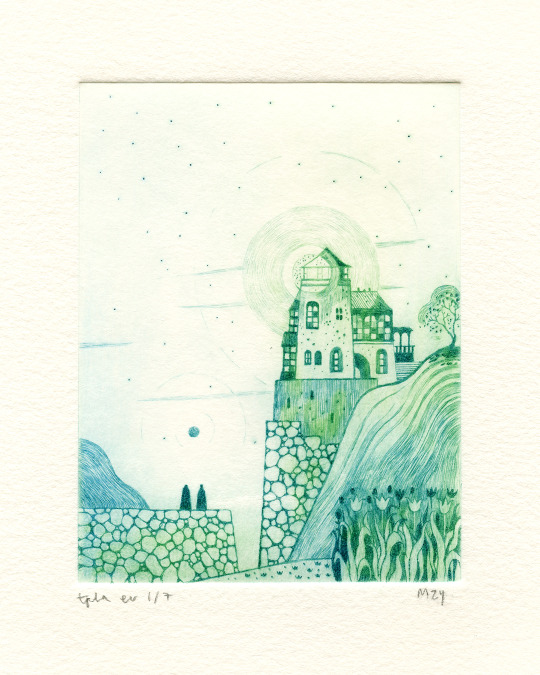#intaglio
Photo
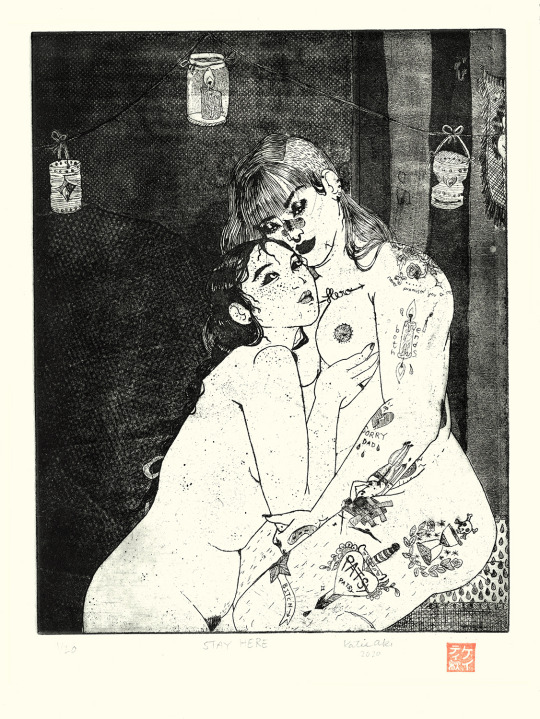
Stay Here
January 2020
etching on cotton rag
Hero and Frankie ❤️
(both she/her)
instagram | twitter
#KatieAkiPresentsTheWasteland#etching#intaglio#traditional art#lgbtq art#lesbian#lesbian artist#sapphic art#sapphic#wlw#original content#original characters#Hero Sasaki#Hero#Listening Church#Knife Church#Frances Sasaki#Frankie Sasaki#Frankie#artists on tumblr
4K notes
·
View notes
Text
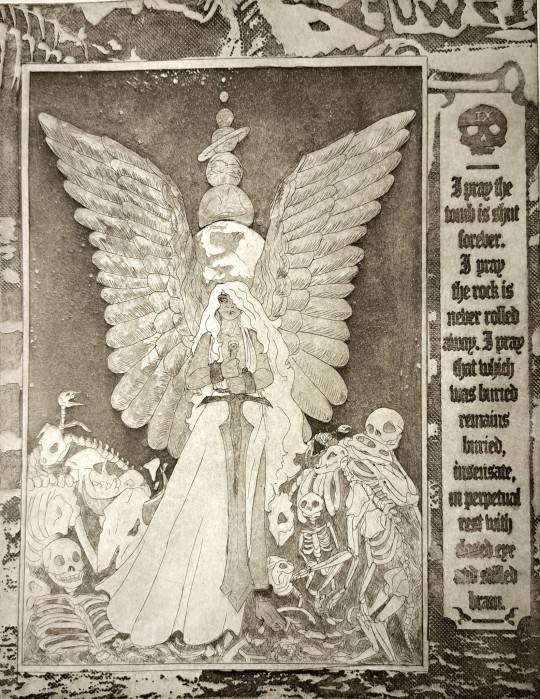
Intaglio (etching) final from this semester. Why wait for the Alecto cover when you can make your own :]
I used line-etch, aquatint, and screenprint onto copper as a resist, progress photos under the cut :)
the one of the screen also has my classmate's stuff on it lol

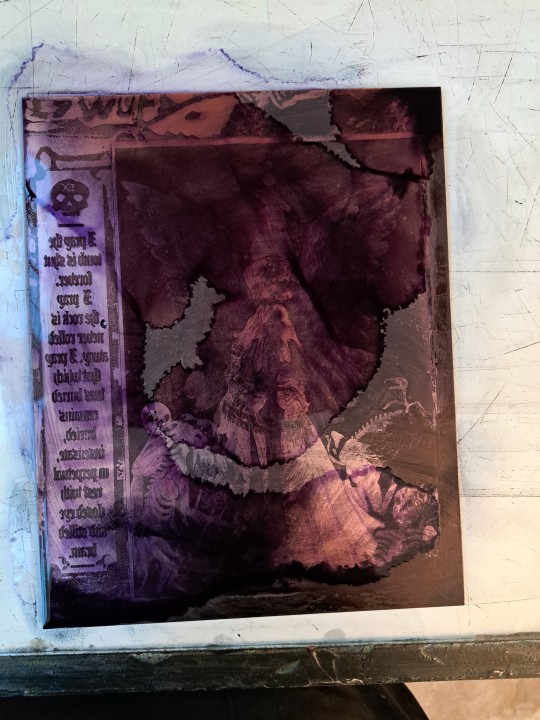
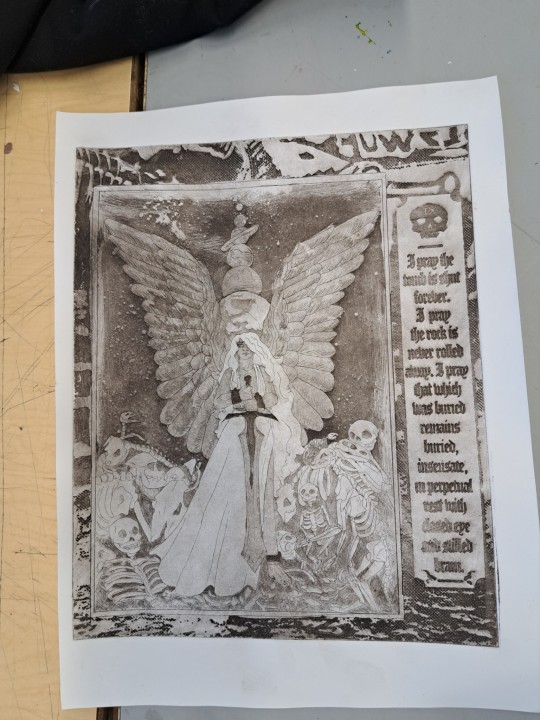


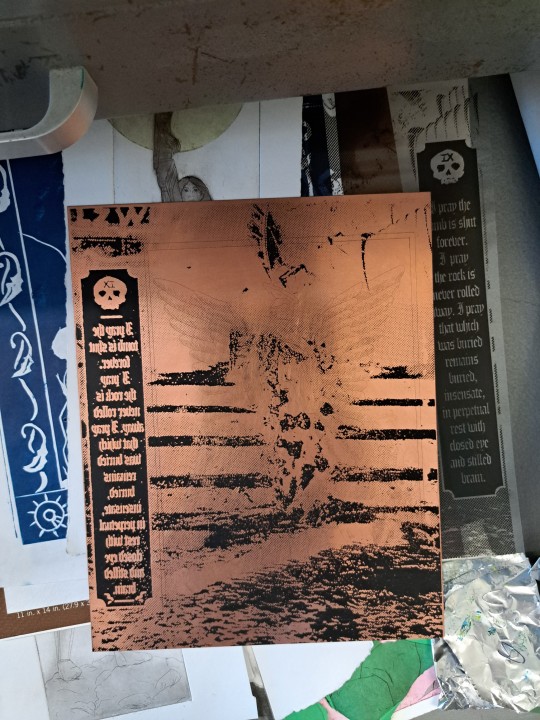


#the locked tomb#alecto the ninth#nona the ninth#alecto tlt#gideon the ninth#harrow the ninth#intaglio#etching#printmaking#2023 art#almost posted my Full Legal Name in one of the progress photos. whoopsies!#i'll probably swap out the photo for a higher quality one once i get my scanner functioning but for now this is fine
409 notes
·
View notes
Text

~ Scaraboid gem/intaglio with griffin (set in modern gold loop).
Culture: Greek
Period: Classical
Date: 425–400 B.C.
Medium: Bronze
#ancient#ancient art#history#museum#archeology#ancient history#archaeology#greek#ancient greek#classical period#scaraboid gem#intaglio#griffin#425 b.c.#400 b.c.
866 notes
·
View notes
Text

Amethyst Intaglio Circa 1st Century, B.C. - A.D. Roman, Possibly Carved by Master Gem Carver, Dioscurides, Who Was The Favorite Gem Carver Of Emperor Augustus
Source: Archeology and The Ancient Worlds via Facebook/Meta
#amethyst#intaglio#ancient jewelry#precious gemstones#high jewelry#luxury jewelry#fine jewelry#fine jewellery pieces#dioscurides#emperor augustus
457 notes
·
View notes
Text

hot off the presses
#for the record I enjoy the dirty border. but not the scratches…#gotta erase those#intaglio#etching#artists on tumblr#my art#original art#jellyfish
160 notes
·
View notes
Text

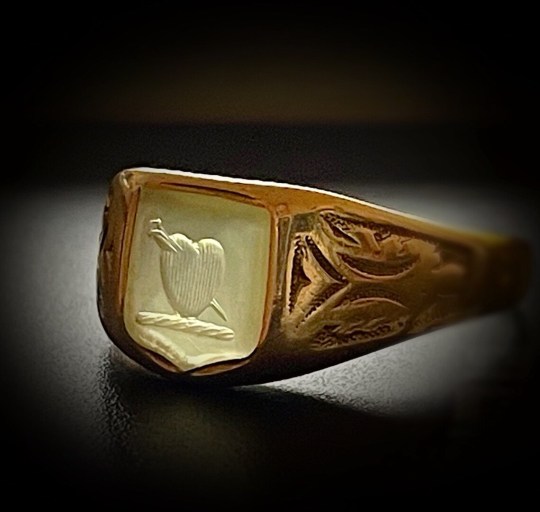
Victorian 14k Gold Chalcedony Intaglio Ring
196 notes
·
View notes
Text
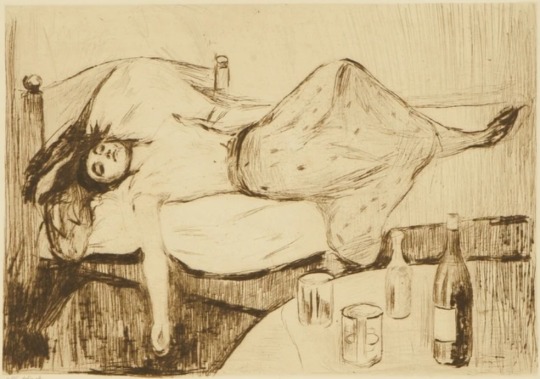
Edvard Munch (Norwegian,1863-1944)
The Day After
Intaglio print
153 notes
·
View notes
Text


Double-Sided Reverse Intaglio Goldfish Earrings. Made by William James Thomas in London, ca. 1870. Each earring is comprised of two crystal dome halves that have been etched/painted with matching goldfish and then mounted back to back with gold settings. From the British Museum collection, museum number: 1978,1002.148
(Source: britishmuseum.org)
#earrings#jewelry#decorative arts#1870s#late 1800s#victorian#british design#animal motif#fish#marine life#rock crystal#intaglio#metal#gold#yellow#orange#brown#beige#clear
308 notes
·
View notes
Photo
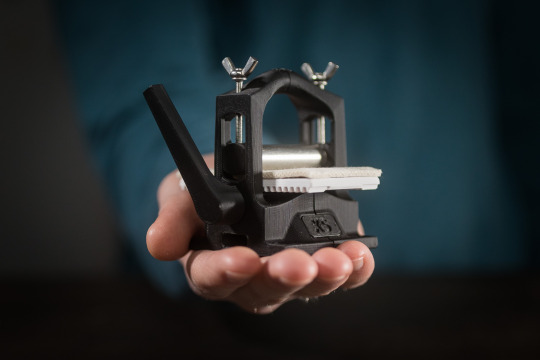
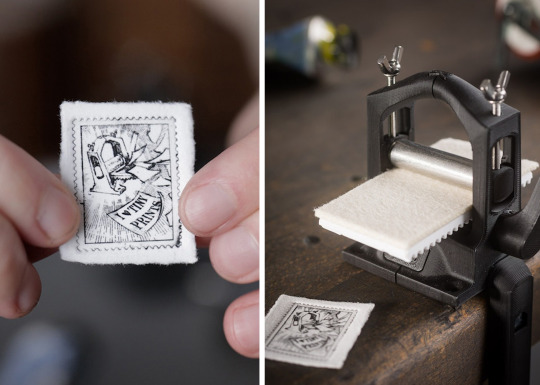

The Open Press Project is Making the World’s Smallest 3D-Printed Press Even Tinier
2K notes
·
View notes
Text
Etching and Acid Baths and Surrender
(this is another classic from my personal site I'm belatedly resharing on tumblr, ftr)
Friends, I just finished teaching the last third of a course on print production, and between that and the whole thing with twitter's crop changing (somewhere? not for me but somewhere?) I've found myself thinking a lot about copper etching and my relationship with the acid bath.
So, first up, copper etching is an art form where you engrave (through various means) thin grooves into a copper plate, then squeeze thick ink into those grooves, then wipe off the ink on the face of the plate, then soak paper so it's very soft, then push it all through a press.The pressure forces the paper into the ink-lined grooves of the plate, pushing the ink onto the paper, and you thus transfer the image from your copper plate to your paper. It's a magnificent art form you've certainly seen examples of, even if you didn't know! Here, a Rembrandt:
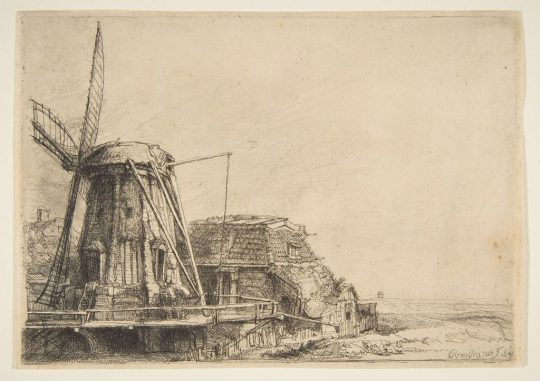
There's a lot of ways to create these grooves in the plate; Rembrandt used a steel point and scratched them in, a technique called drypoint. Later, artists used a technique where a waxy resist would coat the plate, then drew lines in the resist, then soaked the plate in acid.
This is the acid bath of which I speak.
There's a few ways to apply resist to a plate, and they give you different effects when you etch with them. First is a hard resist, which is a thick, firm wax that coats the plate and is removed by using that steel drypoint tool to create thin line work, like this Doré hatching:
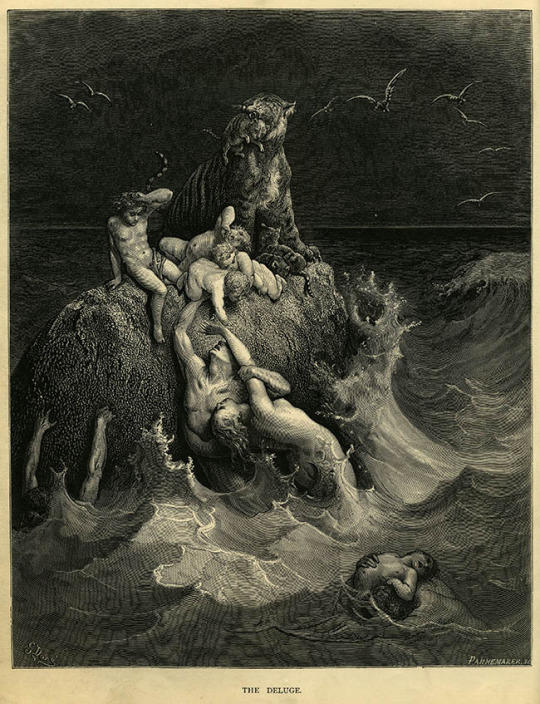
You can also use soft resist, a malleable wax that allows you to press textures into it, like Barbara Smith has in her piece "Textures" here:
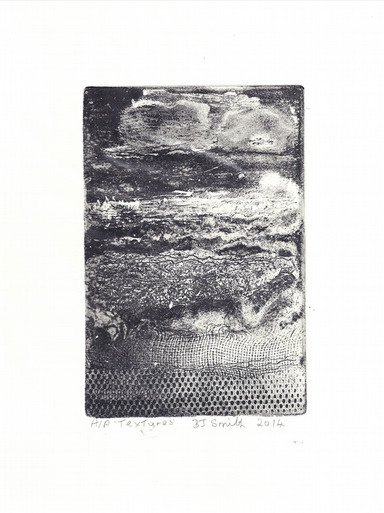
(my terminology might be a bit off, I'm noticing as I google, but hopefully the metaphor will still stand)
And the third method, my fav, is aquatint; a process where you add a resist that is .. spotty. Something like a light spray, or a dusting of wax, so that the plate is covered with a rough, dithered dot pattern of resist, with exposed copper in between. Example via Wikipedia:

I decided to try out copper plate etching, also called intaglio print making, after seeing David Blackwood's work, where he works with aquatint extensively:

Aquatint lets you lay down fields of tone, which he uses in great contrast and collaboration with the linework he etches into the plate as well. It's magnificent work, but it's made all the more miraculous when you understand the whole thing with the acid bath. So, when you put a copper plate into the acid bath, anywhere on the plate that isn't protected by hard, soft or aquatint resist (also called ground) is slowly dissolved into the acid, creating little grooves. The longer it's in the bath, the deeper the grooves - kind of.
The acid is fickle, and the more copper already dissolved into it, the slower it will dissolve new copper. And that's a problem because you want to control exactly how deep those grooves go; the deeper the groove, the more ink it will hold, the darker the line will be on paper. Under-etch your plate, and your lines will be faint, hold very little ink, and be extremely hard to get ink INTO when you apply it before making a print.
But you can't know this until you take all that resist off the plate, wash it, and ink it up and print it.
OVERetch your plate, and the acid will start to eat the copper away from under your resist, widening your lines or flattening out your aquatint, so it's easy to get ink into the lines, but hard not to wipe it back out when you try and wipe ink off the un-etched face of the plate.
Again, not obvious until you go and try printing your plate.
And with intaglio, by which I mean copper plate etching, you might want lines of varying darknesses - you might want aquatint of varying darknesses - and so you will be adding and removing resists of various kinds, and etching and re-etching your plate over and over again.
And you can do various things to get the feel for the acid bath's ... acidity ... on the day you go to etch something in it, but depending on the size of your bath, you etching a large plate for a while might change the bath's acidity. Worst is if it's fresh and you didn't know.
So this whole art form, whereby people produce some of the most precise and exquisite pieces in the north western historical canon IMO, is actually an absurd collaboration with a rogue chemical that may or may not do what you want at any point in time.

And by my third year of making work like this, I had concluded that you simply had to think of the acid bath as a rogue collaborator who you handed your plate off to over and over again throughout your process. You had to just take a deep breath and accept chaos as an element.
Yes, you did your best to prepare your plate, get the right resist on it, draw the right lines where you wanted them; and yes you set a timer and kept an eye on your plate and checked the etch over and over again - but in the end you were teaming up with chaos chemistry.
And I loved it! I loved the surprises you got from acid bath, even if they went against what I had planned. I loved improvising around its unpredictability! Once I accepted that it was part of the practice, I found it exhilirating.
And for me, that's the appeal of all traditional media - I can't predict every little thing, I'm not 100% in control at all times, and artwork has to happen despite all that.
And so I expanded this concept for myself out to my larger practice. When I send a file to print? I'm collaborating with a printer; both the person, who I can maybe talk to, and the machine, that will have its own peccadillos. I prepare as best I can and still I may be surprised.I'm not saying I never threw out plates that got way out of hand, and I'm not saying I never had a print run of my work I had to send back or reprint - I'm just saying that my thought process around them has changed, so I allow for a wider range of surprises than I used to.
So when everyone was going on about the twitter crop finally changing, and I realized I didn't really care, I noticed that I had expanded this concept to publishing online as well. I prep a nice jpg and then I take a deep breath and accept twitter's chaos in collaboration.
And that's how I discovered that, to me, twitter is just another acid bath.

Read the full article
165 notes
·
View notes
Text
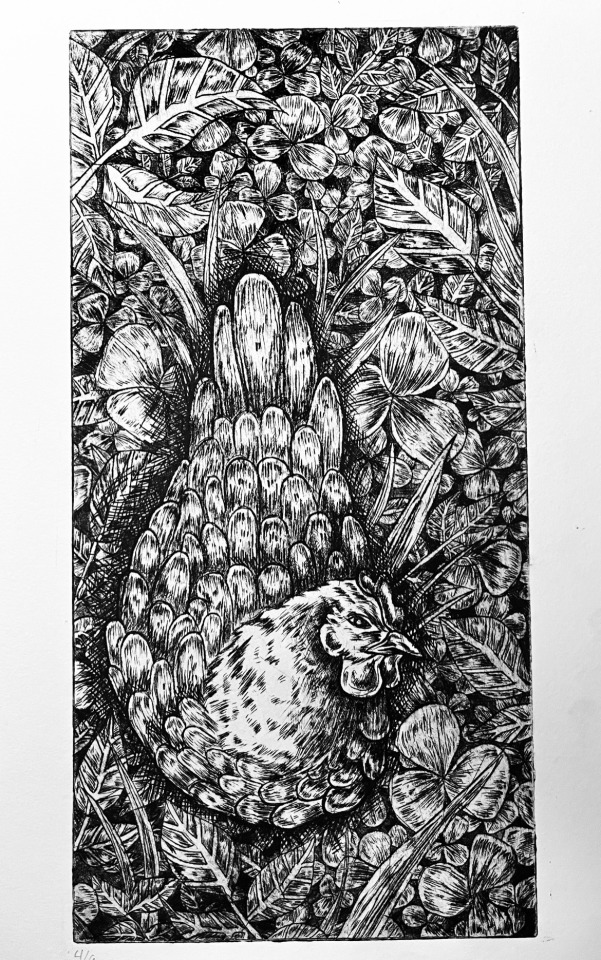
🌾chicken drypoint🌾
instagram - @hungryconcrete
#artists on tumblr#illustration#illustrative art#illustrator#nature#traditional art#art#artwork#chicken#chicken art#printmaking#print#drypoint#intaglio
199 notes
·
View notes
Text

also it’s been fully etched :) will do test inks next week fingers crossed
#intaglio#desert duo#tw blood#tw death#tw murder#i fucking guess#goodtimeswithscar#grian#sharky’s art tag
196 notes
·
View notes
Text

Ghost Hunt, Line etch + aquatint intaglio, Kim Craig 2024
135 notes
·
View notes
Text
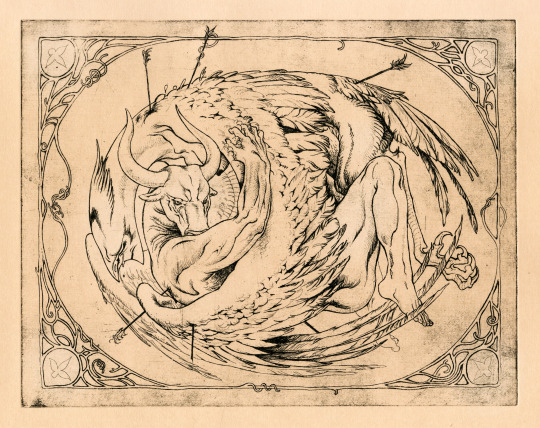
Love In Hard Times
Intaglio etching print for class, been a lot of grief in my communities lately, and the recent uptick in anti gay+trans legislature and propaganda has been one of the things weighing heavily on me recently. Hold on to love! Look out for one another!
Itch.io / Redbubble / INPRNT / Twitter / Patreon
672 notes
·
View notes

